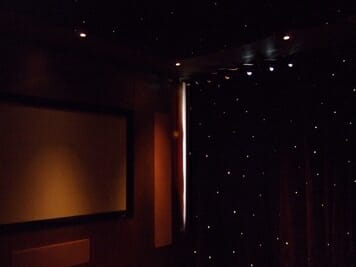The initial enquiry about this project arrived more than a year before the final installation, and involved quite a lot of correspondence between us and our client, interior designer Sophie Bowman, but the final result has been worth it, with Sophie’s client reportedly delighted with the finished room.
The project, in a house in London, was to create a new Home Cinema room, with a level of lighting appropriate to this activity. Sophie needed to black out some large windows, and thought that a star curtain would do this job very effectively, while also adding a lighting feature. The client was also keen to have a star ceiling effect, and Sophie opted to achieve this using the same fabric that she had selected for the curtain.
Starscape’s star cloths are normally manufactured from black wool serge, but Sophie selected her own fabric and our drapes specialists made this up into the right shapes for the curtain and ceiling panel. We then added optical fibre harnesses, with “tails” of a length to suit the proposed locations of the two halogen light sources.

The installation is probably best described in Sophie’s own words, from an e-mail written as the specification was taking its final shape: “The distance from the ceiling panel to its light source isn’t that huge as we have managed to conceal the white box (light source) up in the suspended ceiling so it is placed slightly to one side of centre of the panel – I would allow 2.5 metres from the centre of the panel which is 90″ x 90″ and that really is over estimating but gives us leeway for moving the light source if it should become necessary.”

“The light source for the starcloth is also located in the ceiling void and will be placed centrally in relation to the width of the curtain – because the curtain will be pulled if necessary to the centre of the pole, exposing the door on the right hand side and the window on the left hand side (if facing the front of the curtain). I have yet to make the hole in the ceiling for the tail – it will be done when we fit up and we will do it an an angle where it can’t really be seen & possibly behind the central bracket for the pole. The curtain will have an eyelet heading which I will punch so that the curtain virtually touches the ceiling at the top, so that the wiring (fibre tail) cannot be seen.
So the tail will have to run from the centre of the curtain + the full drop of the curtain i.e. 106″ high plus, say, 2 metres extra to reach the light source. This should allow plenty of length to give us leeway.”

The fabric on the ceiling is stretched across a framework of battens, with a slight tenting at the centre to offset any tendency for the fabric to sag downwards. “What I used to hide the staples on the ceiling section was in fact a braid in the same colour as the fabric with diamante crystal bits on it – just glue gunned on. They catch the light a bit when it bounces round the room,” explains Sophie. “The photos don’t actually do the room justice – it is really good in real life with the twinkling etc.”
Contact Sophie at sophie.bowman@virgin.net
